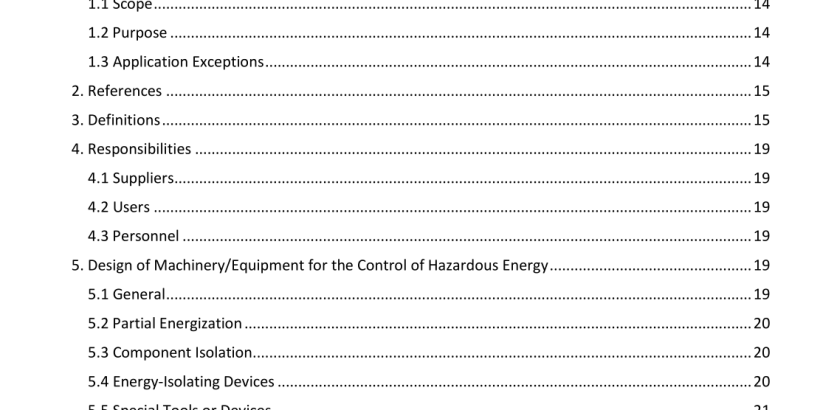ANSI ASSP Z244.1-2016 pdf download.The Control of Hazardous Energy Lockout, Tagout and Alternative Methods
5.6.2 Warnings and Special Instructions
The supplier shall determine if warnings and special instructions are necessary for the machine, equipment or process. Appropriate information shall be provided by the supplier in the documentation. In addition, where the supplier determines that warnings or special instructions are to be located in the area of the hazard on a label, placard or sign, the supplier shall so affix or provide an appropriate label, sign or placard to the user for later installation. (See ANSI Z535 series.)
5.7 Stored and Residual Energy
When stored or residual energy has been determined to present an unacceptable risk, a means for non-hazardous dissipation or safe restraint of the stored or residual energy shall be incorporated into the machine, equipment or process. Devices used for the dissipation or safe restraint of stored hazardous energy shall be designed with a means or method of verifying their position and state. When machinery, equipment or process run-down or coasting is determined to be an unacceptable risk, safeguarding that protects against the hazard or prevents access should be installed. If safeguarding is not practicable, then safe positioning of personnel shall be allowed, but only when such position is predetermined and defined. (See also ANSI B1 1 .1 9.) NOTE: In the case of stored or residual thermal energy, warnings and/or instructions may be provided instead of a device to dissipate or restrain the energy, if such a device is not practical.
6.2 Methods of Hazardous Energy Control
The method of hazardous energy control selected depends on whether the task can be performed with or without energized conditions. The primary method of control shall be lockout unless the user can demonstrate tagout or an alternative method will provide effective protection for personnel (see clauses 7.1 and 8). However, before adopting alternative methods of control, the user shall ensure a risk assessment is conducted that demonstrates the adequacy of the alternative method(s) and the effectiveness of the risk reduction measures. The risk assessment shall be documented and be readily available. NOTE 1: The user’s risk assessment should consider the warnings and special instructions provided by the supplier. NOTE 2: The term “energized conditions” also refers to thermal, radiation and gravitational energy that is inherent and not normally dissipated.
Where the user has a task which is qualified by a risk assessment and lockout is not practicable, either tagout or an alternative method which permits de-energization, energization or partial energization shall be permitted and documented on the machine, equipment or process specific procedure. When a tagout device is used on an energy-isolating device, the tagout device shall be attached at the same location that the lockout device would have been attached.
6.4 Communication and Training
6.4.1 Communication Users shall be responsible for informing persons regarding the relevant provisions of the hazardous energy control program. Users shall also be responsible for apprising appropriate authorized persons of aspects of the hazardous energy control program such as changes in the program, incident experience, performance data, auditing results and other pertinent details.
6.4.2 Training and Instruction The user shall provide initial training or instruction that will ensure that all authorized and affected persons understand the purpose and function of the hazardous energy control program. Training or instruction shall be completed for all newly hired and reassigned personnel before exposure to related hazardous energy sources occurs. NOTE: Training and authorization includes temporary, certain outside contract persons and suppliers. Training shall be such that all authorized persons have an understanding that is appropriate for the level of hazard exposure they encounter.ANSI ASSP Z244.1-2016 pdf download
